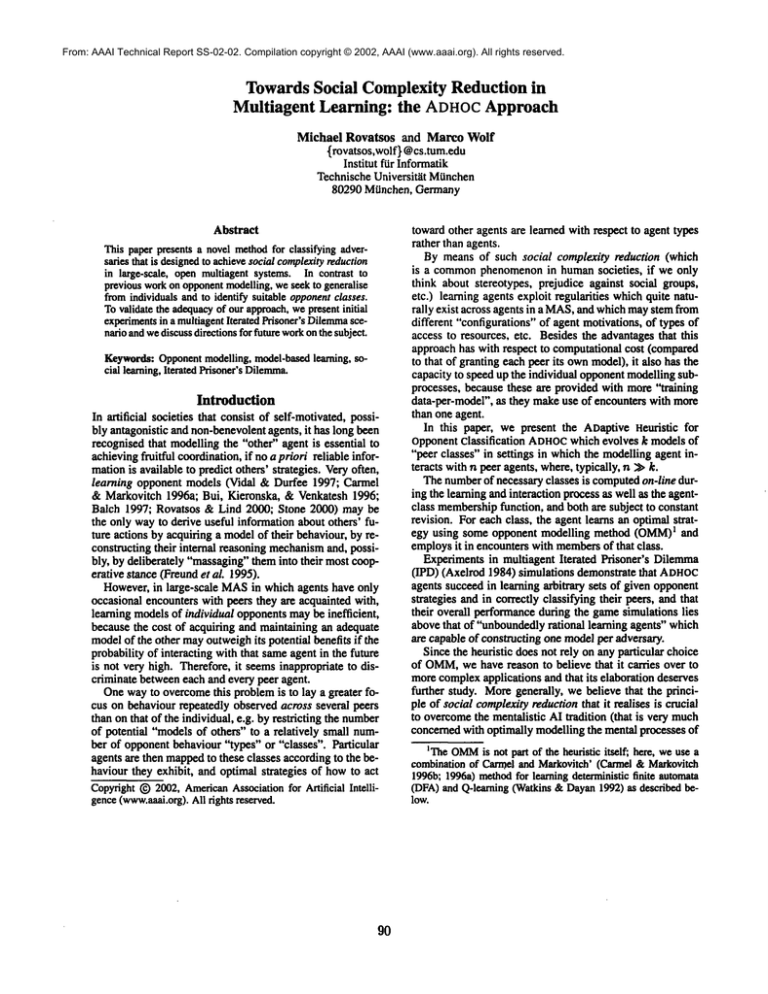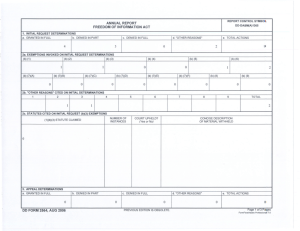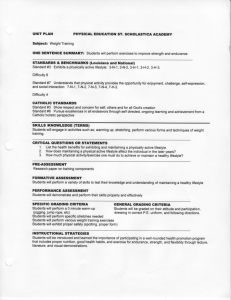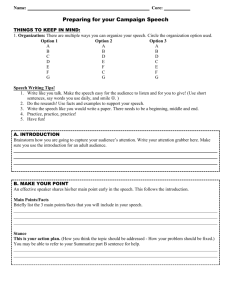
From: AAAI Technical Report SS-02-02. Compilation copyright © 2002, AAAI (www.aaai.org). All rights reserved.
TowardsSocial ComplexityReduction in
Multiagent Learning: the ADHOC
Approach
Michael Rovatsos and Marco Wolf
(rovatsos,wolf} @cs.tum.edu
Institut fur Informatik
TechnischeUniversit~t Mtinchen
80290 Mtinchen, Germany
Abstract
This paperpresentsa novelmethodfor classifying adversariesthat is designed
to achievesocialcomplexity
reduction
in large-scale, openmultiagentsystems.In contrast to
previousworkon opponent
modelling,weseekto generalise
fromindividualsandto identify suitable opponent
classes.
Tovalidatethe adequacy
of our approach,wepresentinitial
experiments
in a multiagentIterated Prisoner’sDilemma
seenarioandwediscussdirectionsfor futureworkonthe subject.
Keywords:
Opponent
modelling,model-based
learning, social learning,Iterated Prisoner’sDilemma.
Introduction
In artificial societies that consist of self-motivated,possibly antagonistic and non-benevolent
agents, it has long been
recognisedthat modellingthe "other" agent is essential to
achievingfruitful coordination,if no a priori reliable informationis available to predict others’ strategies. Veryoften,
learning opponent models (Vidal & Durfee 1997; Carmel
&Markovitch 1996a; Bui, Kieronska, & Venkatesh 1996;
Balch 1997; Rovatsos &Lind 2000; Stone 2000) may be
the only wayto derive useful informationabout others’ future actions by acquiringa modelof their behaviour,by reconstructing their internal reasoningmechanism
and, possibly, by deliberately "massaging"theminto their mostcooperative stance (Freundet al. 1995).
However,in large-seale MAS
in whichagents have only
occasional encounters with peers they are acquainted with,
learning modelsof individual opponentsmaybe inefficient,
because the cost of acquiring and maintainingan adequate
modelof the other mayoutweighits potential benefits if the
probability of interacting with that sameagent in the future
is not very high. Therefore,it seemsinappropriate to discriminate betweeneach and every peer agent.
Onewayto overcomethis problemis to lay a greater focus on behaviourrepeatedly observedacross several peers
than on that of the individual, e.g. by restricting the number
of potential "modelsof others" to a relatively small number of opponentbehaviour"types" or "classes". Particular
agents are then mappedto these classes accordingto the behaviour they exhibit, and optimal strategies of howto act
Copyright(~) 2002,American
Associationfor Artificial Intelligence(www.aaai.org).
All rights reserved.
90
towardother agents are learned with respect to agent types
rather than agents.
By means of such social complexity reduction (which
is a commonphenomenonin humansocieties, if we only
think about stereotypes, prejudice against social groups,
etc.) learning agents exploit regularities whichquite naturally exist across agents in a MAS,
and whichmaystemfrom
different "configurations"of agent motivations,of types of
access to resources, etc. Besidesthe advantagesthat this
approachhas with respect to computationalcost (compared
to that of granting eachpeer its ownmodel),it also has the
capacity to speedup the individual opponentmodellingsubprocesses, because these are provided with more"training
data-per-model", as they makeuse of encounters with more
than one agent.
In this paper, we present the ADaptiveHeuristic for
OpponentClassification ADHOC
which evolves k modelsof
"peer classes" in settings in whichthe modellingagent interacts with n peer agents, where,typically, n :~ k.
The numberof necessaryclasses is computedon-line during the learningand interaction processas well as the agentclass membership
function, and both are subject to constant
revision. For each class, the agent learns an optimalstrat1 and
egy using some opponent modelling method (OMM)
employsit in encounterswith members
of that class.
Experimentsin multiagent Iterated Prisoner’s Dilemma
(IPD) (Axelrod 1984) simulations demonstrate that ADHOC
agents succeedin learning arbitrary sets of given opponent
strategies and in correctly classifying their peers, andthat
their overall performanceduring the gamesimulations lies
abovethat of"unboundedlyrational learning agents" which
are capable of constructing one modelper adversary.
Since the heuristic does not rely on any particular choice
of OMM,
we have reason to believe that it carries over to
morecomplexapplications and that its elaboration deserves
further study. Moregenerally, we believe that the principle of social complexityreductionthat it rcalises is crucial
to overcomethe mentalistic AI tradition (that is very much
concernedwith optimally modellingthe mental processes of
ITheOMM
is not part of the heuristic itself; here, weuse a
combinationof Carmeland Markovitch’(Carmel&Markoviteh
1996b;1996a)methodfor learningdeterministicfinite automata
(DFA)and Q-learning0Vatkins&Dayan1992)as described
low.
individuals) in order to build highly adaptive MAS
with a
particular focus on scalability and bounded
rationality (Russell &Wefaid1991).
Theremainderof this paperis structuredas follows:in the
next section, weintroducethe heuristic andexplain the intuition behindit as well as the underlyingassumptions.Then,
we describe the simulation scenario and the particular OMM
used in our experiments. The subsequentsection discusses
our empiricalresults, and the final section roundsup with
someconclusionsand directions for future work.
The ADHOCClassification
Method
ADHOC
is a generic adaptive classification heuristic that
maintains a bounded number of opponent classes C =
{cl, ¯ ¯ ¯ ok}for a society of agentsA= {al,... an} together
with a (crisp) agent-class membership
function m: A--¢
that denotes whichclass any knownagent aj pertains to
fromthe perspective of a modellingagent ai. It is assumed
that someOMM
is used to derive a particular modelof opponent behaviourc and that this modelcan be used to derive an optimalstrategy for ai wheninteracting with agents
that pertain to this class. Wefurther assumethat interaction
takes place betweenonly twoagents at a time in discrete encounterse =((so, to),... (st, tt)) of length I wheresi and
ti are the actions of ai and aj in each round, respectively.
Eachpair (si, ti) is associatedwith a real-valuedutility
2.
for agentai
The top-level ADrtOC
algorithm operates on the following inputs:
- an opponentaj that ai is currently interacting with,
- the behaviourof both agents in the current encounter e
(we assumethat ADHOC
is called after the encounter is
over) and
- an upper boundk on the maximalsize of C.
It maintainsand modifiesthe values of
- the current set of opponent classes C = {cl,...c~-d}
(initially C = 0) and
- the current membership
function m: A --r C U{.1.} (initiaily undefined
(.I.) for all agents).
Thus, assumingthat an OMM
is available for any c = m(aj)
(obtained via the function OM(c))which provides aj with
methodsfor optimal action determination,the agent can use
that modelto plan its next steps.
Similarity
Measure and OPTALTCLASS
procedure
Thealgorithmstrongly relies on the definition a similarity
measure$(a, c) that reflects howaccurate the predictions
of c regarding the past behaviourof a are. In our prototype implementation,the value of $ is computedas the ratio betweenthe numberof encounters with a correctly predicted by the class and the numberof total encounterswith
2Anyencountercanbe interpretedas a fixed lengthiterated
two-playernormal-form
game(Fudenberg
&Tirole 1991),but the
OMM
we use here does not require that ui be a fixed function
that returnsthe samepayofffor everyenactment
of a joint action
(sz,t~).
91
a (whereonly entirely correctly predicted action sequences
countas "correct" predictions).
This similarity measure is primarily used to decide
whetherto alter the classification of an agent, and also to
determinethe best alternative classification in that case, a
task which is performed by the OPTALTCLASS
procedure
shownin Algorithm1.
The OPTALTCLASS
procedure proceeds as follows: if C
is empty, a newclass is created whoseopponentmodelis
consistent with e (function NEWCLASS).
Else, a set of maximally similar classes Crna=is computed,the similarity of
whichwith the behaviourof aj mustbe at least b (weexplain
belowhowthis boundis usedin the top-level heuristic).
If this set is empty,a newclass is generatedfor aj if the
size of C does not exceedk. Else, OPTALTCLASS
is called
withb = -e~, so that the side-conditionof S(aj, c) >. can
be droppedif necessary.
If Cma=
is not empty,i.e. there exist several classes with
identical (maximal)similarity, wepick the best class according to the heuristic function QUALITY,whichmayuse any
additional informationregardingthe reliability or computational cost of classes.
In our implementation,
this functionis definedas follows:
QUALITY(C)
---+
+
a" #CORRECT(c)
#ALL(c) + ~" ~#all(e)
#asents(e)
7 #known_agents
(1-a-~-’r).
where
#ALL(c)is the total numberof all predictions of class c
in all past games,
- #CORRECT(c)
is the total numberof correct predictions
of class c in all past games,
- #all(c) is the total number
of all predictionsof class c in
the current encounter,
- #correct(c) is the total numberof correct predictions of
class c in the current encounter,
- #agents(c) = I{a ¢ Aim(a) = e}l,
- #known.agentsbe the numberof knownagents,
- COST(C)
is a measurefor the size of the modelOM(e)
and
- a+B+’y < 1.
Thus, weconsider those classes to be most reliable and efficient that are accuratein past andcurrent predictions(usually, a </~), that accountfor a great numberof agents, and
that are smallin size.
Top-level heuristic
Given the OPTALTCLASS
function that provides a mechanismto re-classify agents, wecan nowpresent the top-level
ADHOC
heuristic. In addition to the inputs and output data
structures already described in the previous paragraphs,it
uses the followinginternal parameters:
Algorithm I procedure OPTALTCLASS
inputs: Agentaj. Encountere, Set C, Int k, Int b
outputs: Class e
begin
if C # ~ then
{Computethe set of classes that are most similar to aj, at
least with similarity b }
Cm==
---- {clS(a,e) -- maxc,¢eS(a,c’) A S(a,c) ~_
ifC,n== # 0 then
{Return
the"best"
ofthemost
similar
classes}
returnargmaxcee.~..
QU^UTY(c)
else
{Createa newclass, if[C[ permits, else, the "highsimilarity" conditionis dropped}
if ]C[ < k then
return NEWCLASS(e)
else
return OPTALTCLASS(C,/%
--oO)
endif
endif
else
return NEWCLASS(e)
endif
end
ence if one such modelexists or that it is used to form a new
category unless no more "agent types" can be stored.
Algorithm 2 ADHOCtop-level heuristic
inputs: Agentai, Encountere, Integer k
outputs: Set C, Membershipfunction m
begin
c ~- ra(a~,)
{Thesimilarity values of all classes are updateddependingon
their prediction accuracyregardinge}
for all c E C do
i ,c)
S(a~,e) +- ¢orrect(a
=u(=~)
endfor
if c = J- then
{ Unknown
aj is put into the best sufficiently similar class that
understands
at least e, if any; else, a newclass is created, if
k permits}
m(aj) ~" OPTALTCLASS(C,
h, aj, l)
ifm(aj) ~ then
c ~- c u {m(a~)}
end if
else
{c is incorrect wrt aj or very stable}
ifS(a~,
c)<.6vu(e)
>__
~
- an encounter comprehensionflag ecflc) that is true, whenever the opponent model of some class c "understands"
(i.e. would have correctly predicted) the current encounter;
- an "unchanged" counter u(c) that counts the number
past encounters (across opponents) for which the model
for e has remained stable;
- a modelstability threshold I" that is used to determinevery
stable classes;
- similarity thresholds 5, Pl and P2 that similarities S(a, c)
are compared against to determine when an agent needs
to be re-classified and which classes it might be assigned
to.
During a given encounter with opponent aj, it proceeds as
presented in the pseudo-code description of Algorithm 2.
At the beginning, we set the current class e to the value
of the membership function for the opponent aj. Then, we
update all classes’ current similarity values with respect to
aj as described above, i.e. by dividing the numberof past
encounters with aS that would have been correctly predicted
by class c (correct(aj,c)) by the total number of past encounters with aj (all(aj)).
If aj has just been encounteredfor the first time, m(aj) is
undefined(c = .1_), and aj is put into the best class that correctly predicts the data in the current encounter e. Since only
one samplee is available for the newagent, setting b -- i in
OPTALTCLASS
amounts to requiring that candidate classes
correctly predict e. However,this condition is dropped inside OPTALTCLASS,
if necessary. In that case, that class
will be chosen for which QUALITY(C)
is maximal.
So for the case of encountering a new agent, the algorithm
ensures that the agent is either assigned to a (reasonably general and cheap) modelthat is consistent with current experi-
92
{Re-Classify
ajtoa highly
similar
c,ifany;
else
create
a
newclass if k permits}
m(a~) OPTALTCLASS(C,aj,
k, pl)
if m(aj) ~[ then
c <--c u {m(aj)}
end if
else
{ Theagentis re-classified to the maxinmllysimilar(if also
very stable) class}
C~ ~-- OPTALTCLASS(C,k,
aj,I~)
ifd E C Aa(d) > cthen
m(a~)
~- c’
endif
endif
OM-LEARN(m(aj),
{ Modelof ra(aj) wasmodifiedbecauseof e
if ec~m(u~) ) true th
en
{Reset similadaes for all non-members
ore}
for all a’ E A do
ifm(a’) # c then
S(a’,c)4-
endif
end for
endif
c ~- c - {dlVa.,n(a)#
end if
Next, consider the interesting case in which m(aj) # .L.
In this case, weenter the re-classification routine to improve
the classification of aS is possible. To this end, we choose
to assign a newclass to aj, if the similarity between agent
aS and its current class c falls below somethreshold 6 or if
the model c has remained stable for a long time (u(c) >_
(which implies that it is valuable with respect to predictions
about other agents). Also, we require that candidate classes
for this re-classification be highly similar to aS (b ---- Px).
before, if no such classes exist, OPTALTCLASS
will generate a newclass for aS, and if this is not possible, the "high
similarity" conditionis dropped-wesimplyhaveto classify
aj one wayor the other.
In the counter-case(high similarity and unstable model),
we still attempt to pick a newcategory for aj. This time,
though,we only consider classes that are very stable, very
similar to aj (P2 > Pl), and we ignore classes output
OPTALTCLASS
that are new (by checking "if d E C...’3.
The intuition behindthis is to mergesimilar classes in the
longrun so as to obtain a minimalC.
After re-classification, we update the class m(aj) by
calling its learning algorithm OM-LEARN
and using the
current encountere as a sample. The "problemcase" occurs
if e has causedchangesto modelc becauseof errors in the
predicted behaviourof aj (ecj~m(aj)) = true), because in
this case, the similarity values of m(aj) to all agents are
no morevalid. Therefore, wechooseto set the similarities
of all non-members
of e with that class to 0, followingthe
intuition that since c has been modified, we cannot make
any accurate statement about the similarity of other agents
with it (rememberthat wedo not store past encountersfor
each knownagent and are hence unable to re-assess the
values of S). Finally, we erase all emptyclasses fromC.
Whatthis heuristic actually doesis to create newclasses
for unknownagents or to put them into suitable classes
if creating newones is not admissible. After every encounter, the best candidateclasses for the currently encountered agent are those that are able to best predict past encounterswith it that havebeenstored in S. At the sametime,
goodcandidateshaveto be modelsthat havebeenreliable in
the past and low in computationalcost. Asfar as action selection is concerned,a twofoldstrategy is followed:in the
case of knownagents, agent ai simply uses OM(m(aj))
wheninteracting withagent aj, and the classification procedure is only called after an encountere has beencompleted.
If an unknown
agent is encountered,however,the mostsuitable class is chosenfor action selection in each turn using
OPTALTCLASS.This reflects the intuition that the agent
puts muchmoreeffort into classification in case it interacts
with a newadversary,becauseit knowsverylittle aboutthat
adversary.
Althoughall this maylookfairly simplefroma theoretical
point of view, it turns out to be veryeffective in practice,
even given a naive choice of the COST
and S functions and a
fairly ad hoc determinationof the parametervalues 6, Pl, P2
and 7.
In the followingsection weturn to the scenario we have
chosenfor an empirical validation of the heuristic and to
the details of combiningADHOC
with an OMM
for a given
application domain.
ADHOCin Multiagent
IPD Simulations
The scenario we have chosen to test the adequacyof our
approach is fairly common
and well-studied in the field
of MASresearch: the Prisoners’ Dilemma(Luce & Ralffa
1957), a normal-formgamefor two players with action options C (cooperate) and D (defect) for both players and
payoff distribution as shownin Table 1. Moreprecisely,
our version of the multiagent Iterated Prisoners’ Dilemma
93
D
Table 1: Prisoners’ Dilemma
payoff matrix. Matrix entries
(ui,uj) contain the payoff values for agents ai and s for
a given combinationof row/columnaction choices, respectively.
Figure 1: A DFArepresenting the TIT FORTATstrategy in
the PDgame. Edgelabels represent "own"action choices
andstate labels the other’s reactionsto these actions.
is basedon a toroidal grid within whichn agents moverandomlyand play with peers they happento be in the same
caret with (if morethan two agents are co-located, all of
themplay with each other in a randomorder). Sucha game
consists of I iterations, and a total of N steps (meaning
discrete moveson the grid) are executedin one simulation
(wherethe numberof iterated gamesdependson howoften
agents meet).
This simulation scenario, albeit simple, is complex
enoughto illustrate the necessity of strategy adaptationfor
everyagent, andit also bears a potential for cooperationthat
has to be exploitedif self-interested agentsintendto collaborate effectively. Also, its simplicity enablesus to conduct
simulationswith large numbersof agents, so that the emergenceof "social complexityreduction" can be verified (if
n ::~ k does not hold, one modelcan easily be maintained
for everypeer).
As far as finding an adequateopponentmodellingmethod
for the task of learning to play an IPDoptimally against a
single opponent is concerned, a combinationof the DFA
learning algorithm proposed by Carmel and Markovitch
(Cannel & Markovitch 1996b; 1996a) and standard
learning (Watldns&Dayan1992) is chosen, the details
whichwe can only sketch here for lack of space. Duringany
encountere, a~ attemptsto learn the automatonthat represents the strategy of aj, wherestates are labelled with the
actions of aj and state transitions dependon a~’s ownactions. Figure 1 depicts one such automatonfor the famous
TIT FORTAT(Axelrod 1984) strategy.
Apart from the data stemmingfrom e, the DFAstores a
set of past encounterswith that sameclass to provide for
sufficient learningdata.
In parallel with the evolution of the DFA,a table of Qvalues is learned whosestate spaceis the current set of DFA
states. Optimalaction selection then dependson the current
state as tracked by the DFAof c(aj) during an encounter
with a knownagent aj (with additional Boltzmannexploration to guidethe search).
In the ease of encounteringa newagent for whichno DFA
and Q-table are available, a modified version of the OPTALTCLASS
function is used, where S(a, c) is defined in
termsof correctly vs. incorrectly predictedturns (i.e. individual actions) rather than entire encounters.Thismodification is necessary,since duringthe first iterated gamewith a
stranger the modellingagent does not possessdata regarding
entire encounters.
Also, the first action in an encounter with an unknown
agent is chosenrandomly,and this is also the case if OPTALTCLASS
outputs a newclass that is only consistent with
a small initial portionof this encounter.
Of course, there exists a widerangeof alternatives to this
opponentmodellingand strategy selection algorithm,e.g. to
modelopponentsin a probabilistic fashion. However,the
chosen OMM
is capable of learning an adequate representation of the opponent’sstrategy in principle, and it meets
certain criteria that should be warrantedby any methodthat
is to be used in combinationwith the ADHOC
heuristic:
should be capable of learning a model that
1. The OMM
adequatelyrepresents the opponent’sstrategy and which
can be used to derive an optimal policy for the modelling
agent.
In our scenario, this can be ensuredas long as the representational powerof deterministic automatais not exceeded by opponents. Further, the use of reinforcement
learningprovidessafe convergence
characteristics so that,
if the learned DFAis correct, the modellingagent will
convergeto an optimal policy.
2. Defining a similarity measurebetweenany agent andany
existing opponentmodelshould be feasible.
Here, we have used a very simple method to derive
the values for S(a, e) that is basedon weighingcorrect
against false behavioorpredictions.
3. Opponentmodels should allow for the definition of a
"cost" function.
In our case, the cost is simply defined as the number
of DFAstates, so as to prefer simpler automatafor reclassification.
Experimental Results
Wehave conducted two series of experiments with the
present implementation:first, simulations in whichan ADHOC
agent plays against a numberof opponentswith fixed
strategies: "ALLC" (always cooperate), "ALLD" (always
defect), "TIT FORTAT"(cooperate in the first round; then
play whatever the opponentplayed in the previous round)
and ’’TIT FORTWO
TATS"(cooperate initially; then, cooperate iff opponenthas cooperatedin the two mostrecent
moves).Thesestrategies can be represented by very simple
automata,and hence these simulations served as a starting
point to verify whether the ADHOC
agent was capable of
performingthe task in principle, i.e. to generatefour classes
andto convergeto optimalstrategies against all of them.
94
100
Figure 2: Numberof agent classes an ADHOC
agent creates over time (bold line) in contrast to the total number
of known(fixed-strategy) opponents(whichis increased
40 in rounds 150, 300 and 450). The numberof identified
classes convergesto the actual (four) strategies.
To obtain an adequate and fair performancemeasurefor
the classification heuristic, wecompared
the performanceof
the ADHOC
agent to that of an agent wholearns one model
for everyopponentit encountersand to that of an agent who
learns a single modelfor all opponents.
The results of these simulations are shownin Figures 2
and 33. Theyprovethat the agent is indeedcapable of identifying the existing classes, and that convergence
to a set of
opponentclass is robust against entry of newagents into the
system.
This is an importantscalability result, becauseit means
that in the longrun, the agent exhibits satisficing behaviour
evenin very large-scale MAS,
as longas the set of possible
strategiesis relatively small.
Next, let us turn to performanceresults. Here, interestingly, the ADHOC
agent not only does better than an agent
whomaintains a single modelfor all opponents(which is
easy to understand),but also significantly outperformsan allegedly "unboundedly
rational" agent that is capableof construtting a newopponentmodelfor each adversary - even
thoughit is steadily increasing, that agent’sperformance
remainsbelow that of the ADXOC
agent even after 40000encounters. The reason for this is that the ADHOC
obtains
muchmorelearning data for every class modelit maintains
by "forcing" morethan one agent into that model,thus being able to learn a better strategy against everyclass within
a shorter periodof time.
This nicely illustrates anotheraspect of "social complexity reduction":the ability to adapt to adversariesquicklyby
virtue of creating "stereotypes".
3Each graphdepicts the averageof 100simulationson a 10 ×
10-grid.Parameter
settings where:6 ---- 0.3, r = 15, px = 0.6,
p2 = 0.9, k = 80 and I = 10. 6 sampleswherestored for each
class in orderto learnautomata.
Number
of cla~ma
.:~
=
kzilO ..
10
!
t
o
t
i
t
i
i
i
|
t
Sim~l~$onNmzd8
u
~.~.",’~
.~.
...’~~-\.
,¢,~?;,
",~ ..
Figure 3: Comparisonof cumulative rewards between ADHOC
agent, an agent that maintains one modelfor each opponentand an agent that has only a single modelfor all opponentsin the samesetting as above.
Anissue that deserves analysis is, of course, the appropriate choice of the upper bound/~for the numberof possible opponentclasses. Figure 4 showsa comparisonbetweenADHOC
agents that use values 10, 20, 40 and 80 for
k, respectively, in terms of both numberof opponentclasses
maintained and average reward per encounter. Quite surprisingly, even thoughthere seemsto be not muchdifference betweenthe time-spansthat are necessary to converge
to the optimal numberof opponentclasses, there seemto be
huge differences with respect to payoff performance.More
specifically, althougha choiceof k -- 40 instead of k - 80
seemsto havelittle or no impacton performance,values of
l0 and 20 are certainly too small. Howcan we explain this
result? Onthe one hand, it is certainly the case that, the
more modelsare maintained, the moreexploration will be
carried out per modelin order to learn an optimal strategy
against it. Onthe other hand, the fewer modelswe are allowedto construct, the more"erroneous"will these models
be in predicting the behaviourof adversariesthat pertain to
them(until wegather enoughtraining data), since weare not
allowedto makemanydistinctions.
Although
it is certainly true that wehaveto trade off these
two aspects against each other (both extremely high and
extremely low values for k seemto be inappropriate), our
results here (that are in favour of large values for k) contrast the previousobservationthat "creating stereotypes"increases efficiency. Allowingsomediversity during learning
seemsto be crucial to achieveeffective learning andinteraction.
In the secondseries of experiments, we conductsimulations with societies that consist entirely of ADHOC
agents.
With the algorithms presented in the previous sections,
agents seemto exhibit randomhehaviourthroughout these
simulations. This is, in fact, quite understandableconsidering that they havefairly randominitial action selection dis-
95
°’*
.
¯
~
el
i
do--
: -i
i
i
i
|
i
i
Figure 4: ComparisonbetweenADHOC
agents using different k values. The upper plot showsthe numberof opponent classes the agents maintain, while the plot belowshows
the average rewardper encounter. The numberof opponent
classes remainsstable after circa 5000rounds.
tributions (whenQ tables are not filled yet and automataunsettled) andthat, hence,no agent can strategically adapt to
the strategies of others (since they do not havea strategy,
either).
Witha slight modification to the OMM,
however,we obtain interesting results: wesimplyadd the followingrule to
the decision-makingprocedure:
If the automaton
of a class c is constantlymodifiedduring r consecutivegames,weplay somefired strategy X
for r’ games;then we return to the strategy suggested
by OM(c).
Applyingthis rule implies that if an agent identifies a complete lack in strategy on the side of its peers, it takes the
initiative to "comeup" with one (being "creative"), maintain it for a while, and the return to adaptation. The resuits of these simulations, where X =TIT FORTATare
shownin Figure 5, and illustrate that ADHOC
here seemsto
be capableof exploiting, at least partially, the cooperation
potential that exists in the IPD(the sumof agents’ payoffs
clearly exceeds that of a randommixedstrategy combina-
brd~F.mamtr
lq.§
!
!
!
d,,..a, pd.ap,~’e,a,,,~
.--
!
s.s..../~i....... i .......; .................................
i ........
i ........
! .......
~..’....i ....... i .......i .........................................!........!.......
i .
2S.§ .: .....................................
" ........ ¯ ........ ¯ ........ ¯ ........ ’ .......
~ i
i
:
i: .......
~.s...... i: .......i .......i .......i .......~.......i ........
i ........
i ........
......i .......i .......~.......i .......: ........i........
! ........
i ........
i ........
i
:
i
? :
:
¯
¯ l.S
i
1~
i
~0
i
~
i
~00
i
S000
i
6WO
,i
?000
i
~
i
9000 10~0
Figure 5: Average payoff per encounter (10 PD iterations) amongI0 ADHOC
agents. It lies clearly above
25 (=(50+0)/2 for (C,D) combinations) but below
(=(30+30)/2for (C,C) combinations).
tion (114- 10 + I]4.0 + 114.3 + I/4- 5 ---- 22,5), yet
without being able to guaranteethe establishmentof stable
cooperation,either.
AlthoughX was hand-crafted here and althoughthis last
result will surely require further investigation, webelieve
that addingadditional reasoningcapabilities to the OMM
is
possible in order to identify and maintainsuch "adaptationviable" strategies and this is an issue that will haveto be
lookedat in the future.
Still, our experimentsprovethat ADHOC
is at least capable of"trying out" newstrategies withoutjeopardising longterm performance.
Conclusion
This paper summarisesinitial workon a newopponentclassification heuristic called ADI-IOC
whichis basedon the intuition of "categorising"adversaries in multiagentinteractions so as to achieve social complexityreduction in open
MAS
that consist of self-interested, potentially malevolent
agents. To our knowledge,the work presented here constitutes the first attemptto tackle the problemof opponent
modellingin the face of occasionalencountersin large-scale
multiagent systems.
First empiricalresults provethe adequacyof our approach
for domainswhereagents with regular strategies interact in
discrete two-player encounters. Weshowedhowboundcdly
rational ADHOC
agents outperform "unboundedlyrational
ones", which they achieve by combininglearning samples
from all class membersduring opponent(class) modelling.
At the sametime, the experimentssuggest that best performanceresults can be achievedif we allowfor a great number
of classes in the early phasesof learning, so that an initial
lack in the quality of the modelscan be alleviated by using
a great variety of sub-optimalmodels. Moregenerally, we
might infer fromthis observation that using stereotypes is
96
only highly effective if those stereotypes are good- otherwise, it is better to rely on modellingindividualsconsidered
different fromeach other.
As far as interaction amongADHOC
agents is concerned,
we are currently workingon a moreelaborate and moregeneral heuristic than the onepresentedabove(i.e. occasionally
playingfixed, hand-craftedstrategies). Thecentral problem
weare faced with here is the fact that ADHOC
agents cannot
be modelled as DFAsthemselves. First experiments with
heuristics that are basedon the idea of sticking to ownpast
behavioursin case the opponentexhibits randombehaviour
(in order to promotethe establishmentof stable interaction
patterns) appear to producepromisingresults, and deserve
further research.
Manyissues remainto be examinedin the future: first of
all, somelimitations of the algorithmneedto be doneaway
with, most importantly: the restriction to "post-encounter
classification". Ideally, wewouldlike to classify constantly
throughoutthe encounterin order to fine-tune classification
choices and to havethe option of whetherto modifya model
or to re-classify the agent. Further, restricting ourselvesto
two-agentinteractions is clearly unrealistic withrespect to
real-world applications. Also, domainsmore complexthan
that of IPDshould be examined,and generic rules for the
choice of ADHOC
parameters should be derived. Surely,
complexdomainswill also require moreelaborate similarity and modelcost measures.
Secondly,the very importantissue of partner selection
shouldbe lookedat, since dealing withvarious types of peer
agents will normallyimplythat interactions with themwill
differ in usefulness (and these differences, again, maydependon the current goals of the agent). Therefore,it is only
natural to consider agents that havethe ability to choose
whichagent they interact with, at least undercertain conditions. This will not only haveeffects on the performance
of ADHOC
agents, but also on the learning and classification
processas such.
Finally, as we are lookingat social phenomena,
the potential of using communication
to achieve better coordination
has to be explored- since messagesare actions with little
cost andno immediate
utility, their availability is expected
to increasethe adaptabilityandstrategic rationality of intelligent, opponentclassifying ADHOC
agents vastly.
References
Axelrod, R. 1984. The evolution of cooperation. New
York, NY:Basic Books.
Balch, T. 1997. Learning roles: Behavioral diversity in
robot teams. In Collected Papersfrom the AAAI-97Workshop on Multiagent Learning. AAAL
7-12.
Bui, H.; Kieronska, D.; and Venkatesh, S. 1996. Learning other agents’ preferencesin multiagentnegotiation. In
Proceedingsof the Thirteenth NationalConferenceon Artificiallntelligence, 114--119. MenloPark, CA:AAAIPress.
Carmel,D., and Markovitch,S. 1996a. Learningand using
opponent models in adversary search. Technical Report
9609, Technion.
Carmel, D., and Markovitch, S. 1996b. Learning models
of intelligent agents. In Thirteenth NationalConference
on Artificial Intelligence, 62-67. MenloPark, CA: AAAI
Press/MITPress.
Freund, Y.; Kearns, M.; Mansour, Y.; Ron, D.; Rubinfeld, R.; and Shapire, R.E. 1995. Efficient Algorithms
for Learning to Play Repeated GamesAgainst Computationally BoundedAdversaries. In 36th AnnualSymposium
on Foundationsof ComputerScience (FOCS’95),332-343.
Los Alamitos, CA: IEEEComputerSociety Press.
Fudenberg, D., and Tirole, J. 1991. GameTheory. Cam.
bridge, MA:The MITPress.
Luce, R. D., and Raiffa, H. 1957. Gamesand Decisions.
NewYork, NY: John Wiley &Sons.
Rovatsos, M., and Lind, J. 2000. Hierarchical commonsense interaction learning. In Durfee,E. H., ed., Proceed.
ings of the Fifth International Conferenceon Multi-Agent
Systems (ICMAS-O0).Boston, MA:IEEEPress.
Russell, S., and Wefald, E. 1991. Do the right thing:
Studies in limited rationality. Cambridge,Mass.: TheMIT
Press.
Stone, P., ed. 2000. Layeredlearning in multiagent systems. A winning approachto robotic soccer. Cambridge,
MA:The MITPress.
Vidal, J. M., and Durfe~,E. H. 1997. Agentslearning about
agents: A frameworkand analysis. In Collected papers
from AAAI-97workshop on Multiagent Learning. AAAI.
71-76.
Watkins, C., and Dayan, P. 1992. Q-learning. Machine
Learning 8:279-292.
97







